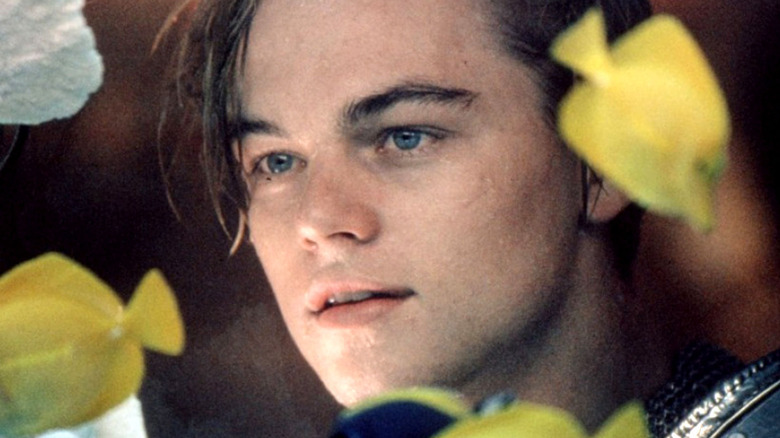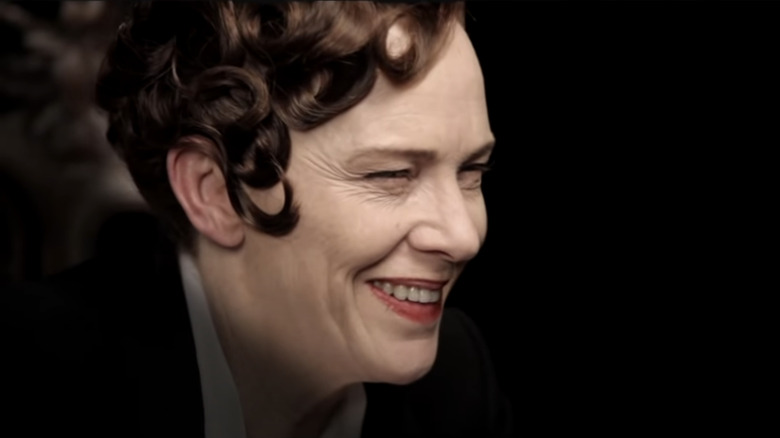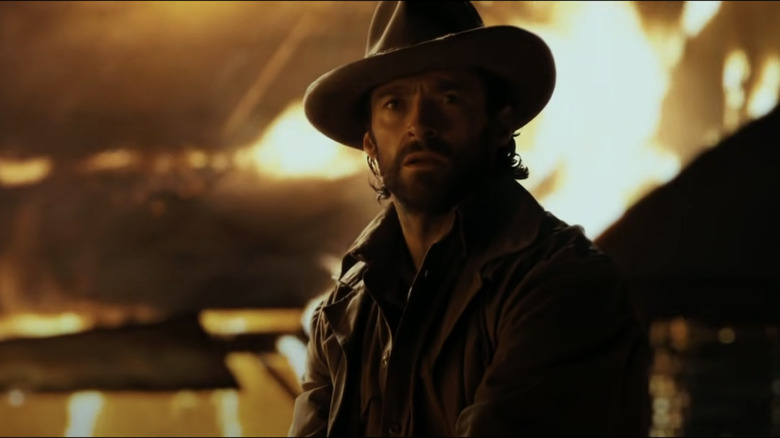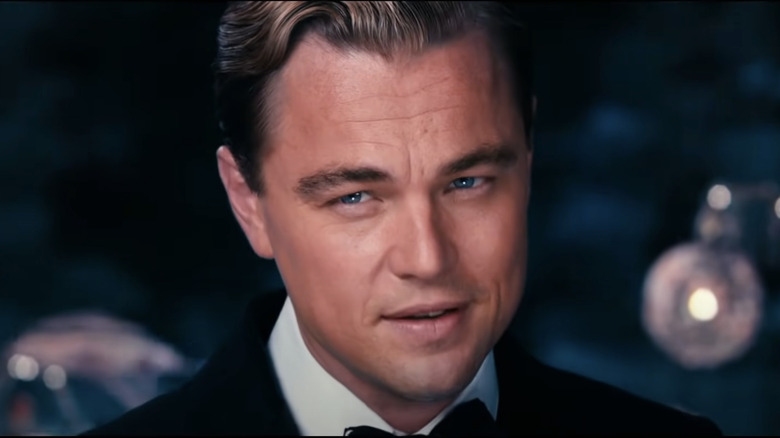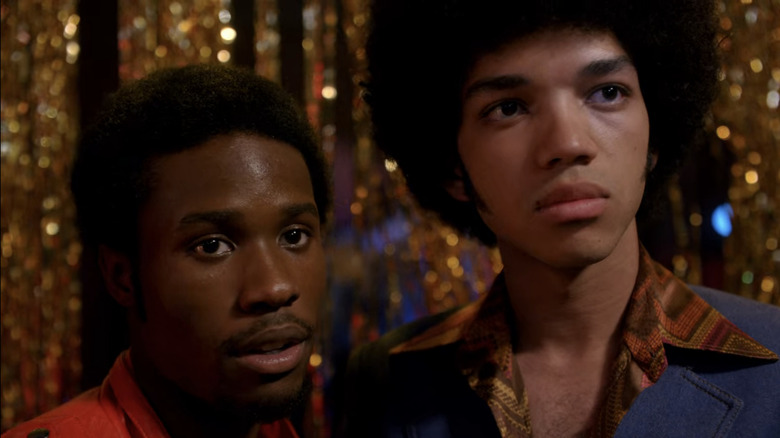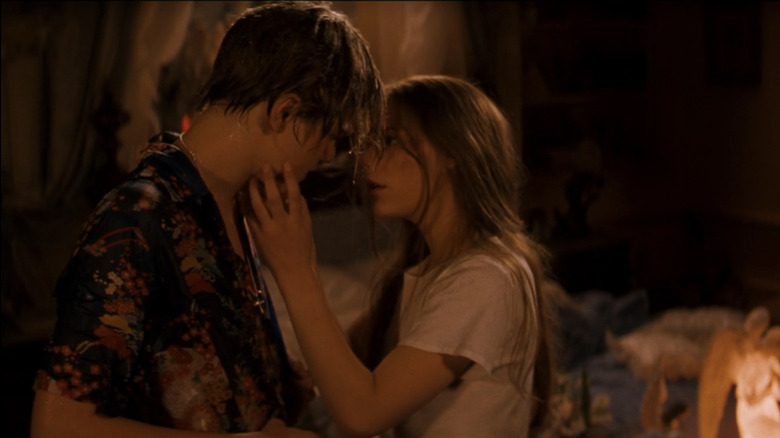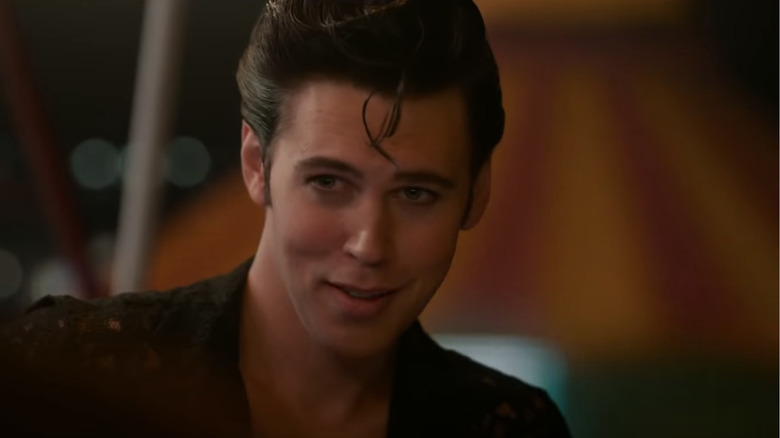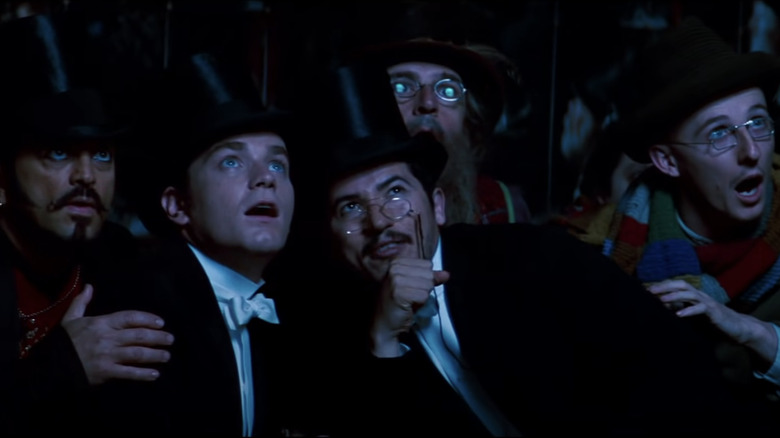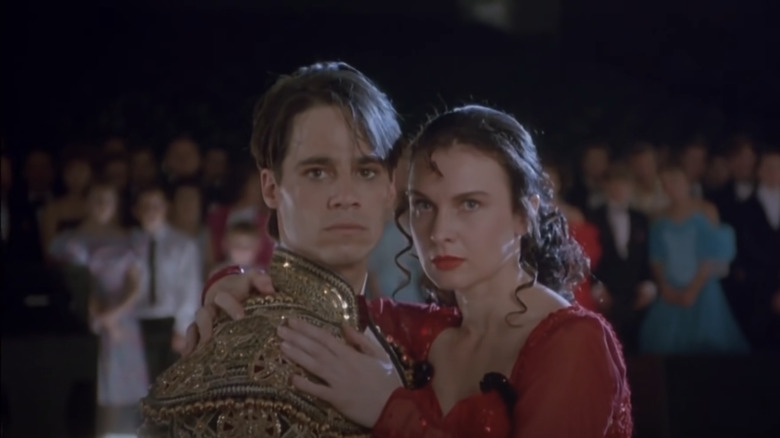Ranking Every Baz Luhrmann Film Worst To Best
Despite the title of this article, there is no "worst" when discussing the work of Australian filmmaker Baz Luhrmann because he has never made a bad film. Or maybe, there is no "best" because he has never made a good film. Luhrmann's bold, maximalist work has won accolades and die-hard fans for decades, yet there is just as passionate a contingency of moviegoers and critics that find his go-for-broke, time-and-genre-hopping excess enervating, like "having a crater-sized parcel of glitter dropped on your head," as The Guardian wrote in 2016.
But whether you live your life according to the gospel of Christian and Satine or you can't figure out what Kanye and Jay-Z are doing in 1920s New York, there's no denying the strength of Luhrmann's cinematic visions. His indelible imagery helped turn Leonardo DiCaprio into a household name, then meme'd him into immortality nearly 20 years later. From turn of the century Paris, to 1970s the Bronx, to 1990s Australia, perhaps the lesson of Luhrmann's work is that there is an opera waiting to burst forth just about anywhere and everywhere. Perhaps those critics bemoaning the lack of substance under all the style are missing the point.
As Luhrmann's next opus, an anything but standard biopic of Elvis Presley, prepares to open around the world, let's take a look at his cinematic body of work, ranked from worst to last.
Schiaparelli & Prada: Impossible Conversations
This last spot is not necessarily "worst," but perhaps close to an Honorable Mention. "Schiaparelli & Prada: Impossible Conversations" is a series of short films directed by Luhrmann in 2012 for the Metropolitan Museum of Art, imagining a dinnertime talk between Miuccia Prada, fashion designer and head of her family's famous label, and legendary 20th century designer Elsa Schiaparelli, played here by Australian actress Judy Davis.
The exhibit was separated into seven themed sections, each showing a pair of complementary dress designs by Prada and Sciaparelli, and accompanied by a snippet of Luhrmann's short film. He shoots the two as if sitting at a long ornate table in a darkened dining room, but the effect is clearly a digital creation. Perhaps getting at the idea that these conversations are happening across time, he shoots Davis in glamorous, 1930's-style lighting, while Prada looks like she's sitting for a TV news interview. Both of them have a great many things to say about life, art, and fashion, but the film rarely delivers on its title's promise of a conversation; most of the time they seem to be talking past each other, if not actively over each other. Luhrmann had been friends with Prada for years (per Vogue), and they would go on to collaborate on "The Great Gatsby" and "Elvis," but divorced from its original context, their work here is inessential.
Australia
Luhrmann goes big and goes home in the 2008 historical romance "Australia." "Moulin Rouge" muse Nicole Kidman plays English noblewoman Lady Sarah, who in 1939 journeys to the land down under to take control of her estranged husband's massive cattle ranch after he dies under mysterious circumstances. Determined to prove herself in these harsh conditions, Lady Sarah leads a cattle drive across the outback to the coastal city of Darwin, winning the respect (and soon, love) of the ranch's rough-and-tumble Drover (Hugh Jackman in full beefcake mode). For a moment, she and Drover and a young Aboriginal boy she's unofficially adopted named Nullah (Brandon Walters) settle into a happy makeshift family. But the forces of history soon come calling, in the form of the Japanese bombing of Darwin and in the Australian government's shameful history of Aboriginal genocide.
From the film's monolithic title on down, it's clear that Luhrmann intends the film to be not just a sweeping epic and love story, but a treatise on his nation's history and the great and terrible things about being Australian. The romance between Kidman and Jackman is lovingly old-fashioned, the kind of thing Luhrmann could do in his sleep. Addressing centuries of racial injustice is a tougher nut to crack, especially as Luhrmann prioritizes his white characters (and audience) learning about racism, rather than his characters of color living it. And despite his good intentions, he can't help but fall back on some unfortunate "noble savage" stereotypes, making Walters' character and his grandfather (the great Australian actor David Gulpilil) avatars of the natural world and suggesting that they have literal magic powers.
The Great Gatsby
Pairing Luhrmann with "The Great Gatsby," F. Scott Fitzgerald's classic novel of American flash and emptiness, seems like a great idea on paper. He had already brought one high school English standard to vibrant life in "Romeo and Juliet," and used modern music and MTV editing to recreate an earlier era of excess in "Moulin Rouge." And plenty of foreign-born filmmakers, from Billy Wilder with "Ace in the Hole" to Wim Wenders with "Paris, Texas," have brought a unique perspective to the American project, often able to see us more clearly than we see ourselves. But the novel had been adapted for film twice before, in 1974 with Robert Redford and Mia Farrow and in 2000 with Toby Stephens and Mira Sorvino, and neither was a great success. Was "Gatsby" cursed? And if so, could Luhrmann break it?
As a visual spectacle, "Gatsby" is a giddy success. Luhrmann gives Jazz Age New York the "Moulin Rouge" treatment, with a soundtrack guided by the twin stars of Jay-Z and Lana Del Rey, powered by a picture-perfect cast that includes Carey Mulligan, Joel Edgerton, Tobey Maguire as narrator Nick Carraway, and his boyhood friend Leonardo DiCaprio in a great performance as the unknowable Gatsby. Maguire's narration — presented here as therapeutic writing during a sanitarium stay -– furthers the "Moulin Rouge" connection, as if this were a spiritual sequel, one doomed romance after another. But the film is high on its own supply, unable to examine its own decadence, and by the end has become an example of the very thing Fitzgerald's book was satirizing. As Christopher Orr wrote in his review for The Atlantic, "When the movie is entertaining it's not 'Gatsby,' and when it's 'Gatsby' it's not entertaining."
The Get Down, Episode 1
Luhrmann and playwright Stephen Adly Guirgis bear witness to the birth of hip-hop in the Netflix one-season wonder "The Get Down," which ran for 11 episodes on the streaming platform in 2016 and 2017. Luhrmann co-wrote and directed the series' 90-minute first episode, in which 1990s rap artist Books (Daveed Diggs) looks back on his teenage years 20 years earlier, when he was a scrappy would-be MC named Zeke (Justice Smith). A chance encounter with a DJ named Shaolin Fantastic (Shameik Moore) turns him on to the brand new sound coming out of the Bronx. Meanwhile, the girl of his dreams Mylene (Herizen F. Guardiola) is desperate to get out of her pastor father's restrictive house and make her way as a disco singer.
Luhrmann's maximalism is toned down here, likely as a mercy to the other directors who would helm the rest of the series, but the visuals are as florid, vivid, and lurid as ever; a disco ball splattered with blood after a gang ambush at a nightclub serves as a striking shorthand for the show's whole approach. Luhrmann forgoes most of his anachronistic tendencies, keeping the show visually and musically grounded in the show's time and place, but shot through with references to the same cultural touchstones that inspired that first generation of hip-hop innovators: Shaw Brothers kung-fu movies, Blaxploitation films and pimp culture, "Saturday Night Fever," "The Warriors." It's a mythic, print-the-legend take on the birth of rap, the kind of thing that a kid living in Australia and staring at his copy of "The Message" might dream up.
William Shakespeare's Romeo + Juliet
What might William Shakespeare think of the fact that stars are still born from his star-cross'd lovers, some 400 years after he set ink to parchment? In 1996 Leonard DiCaprio was a respected young actor, praised for his work in films like "What's Eating Gilbert Grape?" and "This Boy's Life." He had starred in the low-budget indie "The Basketball Diaries," but Luhrmann's frenetic adaptation of "Romeo and Juliet" (stylized as "William Shakespeare's Romeo + Juliet") was his first lead role in a studio picture. The one-two punch of "Romeo + Juliet" and "Titanic" the next year would launch him into the highest reaches of stardom for the next 25 years and counting.
As a screen presence, DiCaprio is handsome and magnetic. As a Shakespearean actor, he's just okay, with none of the confident flow of co-stars Brian Denehy and John Leguizamo, or even Claire Danes as Juliet, who was just 17 at the time of filming. Likewise, the sheer volume of Luhrmann's work here — both in terms of quantity and of loudness — gives the feeling that his one weird trick to getting audiences to appreciate Shakespeare is to simply drown out the language whenever possible. But that sensory overload communicates the all-peaks-no-valleys rush of young love, risking the ridiculous in order to reach the sublime. Many critics at the time only saw the ridiculous in it, taking offense on Shakespeare's behalf — as if the Bard weren't himself a populist, playing to the cheap seats at every opportunity — but the film has endured, like its source material, longer than likely anyone involved ever thought possible.
Elvis
2022's "Elvis" biopic is something of a spiritual sequel to "The Great Gatsby." Both take on a classic, uniquely American story about an iconic figure who serves as a charismatic totem of 20th-century hopes and dreams, well known but forever misunderstood. Each is shot with Luhrmann's signature panache and anachronistic style; "Elvis" is at its best in its early sequences, a whiplash-inducing rush of light and sound representing how thoroughly Elvis Presley disturbed the staid world of post-war America with his integrationist blend of country music, blues, and gospel.
As one might expect for a Luhrmann film, reviews are not so much mixed as they are polarized, with critics either loving it or hating it (or both at once). Former Nickelodeon and Disney teen star Austin Butler has won near-universal acclaim for his sensitive and studied portrayal of Presley; he has the moves and the voice down, even if, like many actors before him, the sideburns don't always fit so well, particularly as he ages into Presley's tortured final years. Less acclaimed has been Tom Hanks' turn as Presley's conniving, manipulative manager Colonel Tom Parker, buried under a thick Dutch accent, a fat suit, and ever-increasing layers of old-age makeup. Hanks clearly relishes the chance to play such a character, and he fits well into Luhrmann's gallery of grotesques, but is perhaps a little too over the top, even in a movie that redefines "over the top" with each new scene.
Moulin Rouge
The film that launched a thousand Tumblr accounts, Luhrmann's 2001 musical extravaganza "Moulin Rouge!" not only served as a mission statement for his entire body of work, but introduced a new kind of movie musical, one built for the era of the mash-up and the iPod. Just like the amped-up beginning of "Romeo + Juliet," "Moulin Rouge!" lets the audience know exactly what kind of movie this is going to be from the very start; penniless romantic writer Christian's (Ewan McGregor) first trip to the titular Paris nightclub is scored to an EDM-thumping medley of "Lady Marmalade," "Smells Like Teen Spirit," "Material Girl," "Diamonds are a Girl's Best Friend," and more. Like its auteur, the film is a musical omnivore, unconcerned with boundaries of genre and good taste, the kind of film — perhaps the only film — that would feature Kylie Minogue as the embodiment of an absinthe stupor, but voiced by Ozzy Osbourne.
The film's plot is almost insultingly simple, a tragic love triangle played out under the stage lights, as eternal romantic Christian vies with the cold but wealthy Duke (Richard Roxburgh) for the heart of glamorous courtesan Satine (Nicole Kidman). Christian and the film both hold true to the bohemian ideals of "truth, beauty, freedom, and love," as once again Luhrmann seeks the sublime in the ridiculous. Satine remains arguably Kidman's most indelible role, living and dying beautifully, while McGregor proved he could do more than Jedi mind tricks (even if Craig Armstrong's vocal arrangements have him pushed to the absolute limit of his upper range). Two decades later, the film has inspired more than just online devotees; a stage adaptation opened on Broadway and took home a slew of Tony Awards in 2021, including Best Musical.
Strictly Ballroom
Luhrmann's best film (at least thus far) is still his first. "Strictly Ballroom" began life as a short stage play conceived by Luhrmann in the mid-1980s while studying at the National Institute of Dramatic Arts in Sydney (per The Guardian). After a successful run at the Wharf Theatre in Sydney, he was offered the chance to adapt the play into a film; Luhrmann agreed, on the condition that he could direct it as well. Perhaps those many years in development with the stage play are part of why the film feels so satisfying, like a band who toiled on their first album's songs for years, perfecting every last moment before getting into the recording studio. On paper, the film is a quaint romantic comedy/sports movie hybrid set in the world of competitive ballroom dancing. Hotshot hoofer Scott Hastings (Paul Mercurio) has lost his latest partner because of the way he flouts tradition in his routines, but he finds a new partner who will follow his steps in Fran (Tara Morice), the mousy daughter of a Spanish immigrant family. Soon, though, it is Fran who is showing him some new steps, in life and in love.
The first of Luhrmann's "Red Curtain Trilogy," "Strictly Ballroom" is a noticeably more modest affair than either "Romeo + Juliet" or "Moulin Rouge!" But while his camerawork is not quite as kinetic as it would soon become, many of Luhrmann's pet ideas and obsessions are already in play. The deep tans, garish makeup, and sparkly costumes of the other dancers ride the same thin line between glamorous and grotesque that his "Moulin Rouge!" costume design does, and the way that performers can't help but bring drama everywhere they go is a constant theme running through nearly every one of Luhrmann's works.
